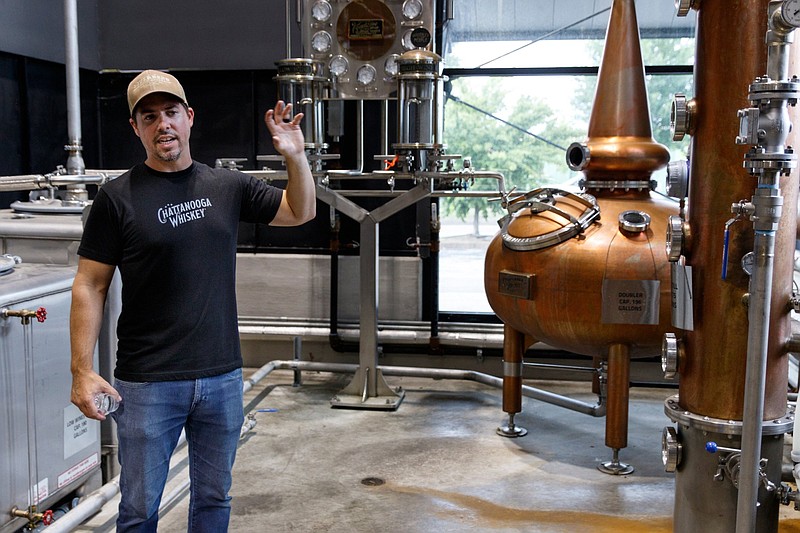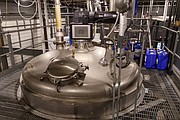After two long years, the Chattanooga Whiskey Co. is ready to launch their new signature products, Chattanooga Whiskey 91 and Chattanooga Whiskey 111.
The latest Tennessee High Malt bourbons will replace the Chattanooga Whiskey 1816 Reserve and Cask as the distillery's flagship whiskeys. Not only is the new-and-improved recipe unique in its brewing and distilling processes, but it is among the first batches of whiskey to be made 100% in Chattanooga in more than 100 years.
It wasn't until 2013 that Hamilton County was legally permitted to distill spirits. Chattanooga Whiskey's 1816 series was actually being distilled in Lawrenceburg, Indiana until the "Whiskey Bill" was passed in Tennessee, allowing Hamilton County to produce their beverages here.
Wanting a product that was 100% locally crafted, the Chattanooga Whiskey Co. decided to create a new recipe to replace the Indiana-distilled batches. After years of experimentation and over 100 barrels of whiskey sampled by experts and connoisseurs, the perfect whiskey was unanimously selected as the new poster child of the distillery's 100% Chattanooga-made whiskey.
Chattanooga Whiskey Co-founder and CEO, Tim Piersant, is eager to roll out the new Tennessee High Malts.
"We're upping the game of the everyday sipping whiskey," said Piersant. "We put a lot of effort into developing this. This was not an overnight process, it took years to develop and we are really happy with the outcome of the product. Across the board, it's a step up."
Chattanooga Whiskey 91, which will replace the 1816 Reserve, and Chattanooga Whiskey 111, which will replace the 1816 Cask, have different recipe ratios than their older counterparts. The flavors developed in the new bourbon whiskeys are deeper and more complex, thanks to the fermentation and aging processes.
At the Chattanooga Whiskey's Riverfront Distillery, the grain mash is fermented at a lower temperature for an extended amount of time compared to other brewers, who typically ferment quicker and at a higher temperature. High temperatures produce alcohol much faster, but the yeast also produce a fruity flavor when exposed to higher heat. The Chattanooga distillery ferments their grain at a cooler level, which takes longer to make alcohol, but doesn't produce as much fruity flavors.
"This allows the complexity of the recipe to shine through in the barrels, as opposed to the [fruity flavors] from the yeast being louder," Piersant explained.
After fermentation, the alcohol is distilled until the desired proof is reached, and then transferred into barrels and aged for at least two years. In the last step before bottling, the whiskey is poured into a Solera Barrel - a giant, charred white oak whiskey barrel that holds the contents of 100 barrels at a time. In this huge vat, the whiskey co-minges and picks up nuances from one another that each batch had developed within its own barrel.
"Every system and every environment will impact the flavor," said Piersant. "[The Solera barrel] helps create a richer and more complex flavor over time as opposed to [the whiskey] sitting in a tank until bottling."
Finally, after over a two-year process, the whiskey is ready to be bottled, packaged and shipped out..
Other than the bold, new flavors of the Chattanooga-made bourbon whiskey, one of the things that Piersant is most excited about is that the product price point will stay the same. Many consumers assumed that the newest craft would see an increase in price from the 1816 series, but Piersant said he is proud that they are not bumping up any costs.
"This is one of the best values on the shelf of any craft whiskey" he said. "We want this to appeal to the masses. The community is what got us here, and we want the community to enjoy our product."
On average, the 1816 Reserve is $35 a bottle, so the new whiskey will match that price. The Chattanooga Whiskey brand can be bought at their Retail Bottle Shop, or at any local liquor store.
The company expects to expand their reach with the new whiskey brands to include the entire Southeast. According to Carrie Kleban, the marketing director for Chattanooga Whiskey, the company is "growing aggressively," and is expanding into six other states in the South within the next six months.
Chattanooga Whiskey 91 and 111 officially hit the shelves in local stores last week, and free tastings of the new High Malt are being offered at the Experimental Distillery on Market Street are now being offered in celebration of the whiskeys' debut.

